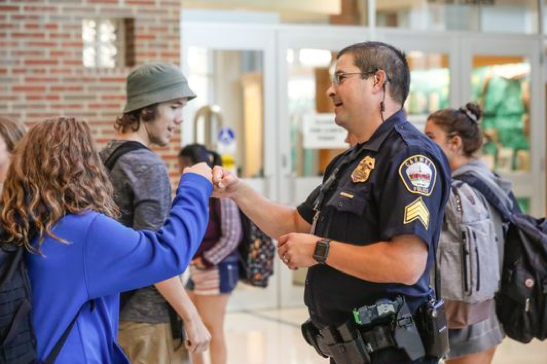School resource
officers (SROs) are now the gatekeepers to an untapped wealth of information.
At their fingertips are computer databases containing well-networked contact
information of every student who has attended the school, along with
photographs and behavior reports. SROs can also utilize social networking web
sites which offer staggering amounts of information. These resources allow SROs
to identify frequently changing gang and drug trends as well as criminally
active juveniles.
Social Media and Intelligence
Because SROs are familiar with the culture of young people and know who
to investigate online, they are at the forefront of social networking and
information collection. The abundance of information presented on sites such as
Facebook and Twitter can be a huge asset to law enforcement across the
country.
Facebook allows its users to post information and pictures on their personal
“wall” covering any topic they wish to write about. Even more intriguing, users
can carry on current, written conversations with friends on their wall for
anyone to see.
Twitter enables its users to send minute-by-minute messages or “Tweets” using
several methods, including mobile texting, instant messaging and Web-based
messaging, to whomever is an accepted “follower.” What makes Twitter
unique is that the messages are sent in real time. Frequently, SROs may
discover information about gang affiliation, narcotics dealings, underage
drinking parties, terroristic threats or plans to disrupt the safety and
security of a school.
Online investigations routinely lead to the discovery of photos that
depict criminal activity. Brenda Miller, chief deputy attorney for Waseca
County, Minn., specializes in juvenile prosecution. She explains, “Photographs
can be used to establish probable cause and later be admitted as evidence.”
According to Miller, “Photos are actually owned by the social networking web
sites, and a person has no expectation of privacy in photographs owned by a
third party unless they are trademarked.”
Working with School Administrators
Successful information collection starts by building cooperative working
relationships between SROs and school principals. David Dahl, principal of
Armstrong High School in Plymouth, Minn., has devised such a program. Dahl
recommends that SROs attend weekly meetings with school administrators. “These
meetings are intended to transfer information between school administrators and
SROs in an effort to prevent juvenile misconduct and provide needed
intervention,” Dahl said.
SROs also need to gain a better understanding of students’ rights in school,
and bring information to school administrators about suspicious activity or
suspected criminal misconduct. SROs also have an obligation to work with school
district administrators and police supervisors who are interested in
implementing communication systems or participating in information sharing
programs. SROs must remain dedicated to building strong relationships with
school administrators and investigating social media in an effort to collect
and disseminate criminal intelligence.
Blake Prewitt, superintendent of Lakeview school district in Battle Creek,
Michigan, typically wakes up each morning to twenty new emails from a social
media monitoring system the district activated earlier this year. It uses
keywords and machine learning algorithms to flag public posts on Twitter and
other networks that contain language or images that may suggest conflict or
violence, and tag or mention district schools or communities.
In recent months the alert emails have included an attempted abduction outside one school—Prewitt checked if the school’s security cameras could aid police—and a comment about dress code from a student’s relative—district staff contacted the family. Prewitt says the alerts help him keep his 4,000 students and 500 staff safe. “If someone posts something threatening to someone else, we can contact the families and work with the students before it gets to the point of a fight happening in school,” he says.
Lakeview’s service is provided by Firestorm, a Georgia company that also helps schools develop safety and crisis response policies. Hart Brown, Firestorm’s COO, told WIRED that earlier this year, the company’s system flagged a post by a student containing a photo of a backpack with a weapon inside. When the school’s principal approached the student on campus, they were carrying the weapon, Brown says.
Desmond Patton, a professor at Columbia, believes social media monitoring can work if managed correctly. “I think there’s an opportunity for schools to use this as a way to support people but I would do so with extreme caution,” says Patton. His lab has collaborated with social workers trying to reduce gang violence in Chicago to train machine learning software to find tweets expressing trauma and loss. The group has shown updates of those kinds often precede posts containing threats, and is hoping to test its algorithms as tool for community organizations in Chicago and New York City.
Scan public posts, targeting topics and locations not individuals, is a rock solid start to any successful school program. In Lakeview’s schools, students receive classes on social media. Those include guidance on privacy settings, but not discussion of the district’s use of Firestorm’s service. Both companies say they have designed their systems to work for different kinds of slang around the country, and frequently update their vocabularies with fresh data.
